Audit, Assurance, Compliance Report: Origin Energy and ASX Principles
VerifiedAdded on 2021/05/31
|12
|2736
|56
Report
AI Summary
This report provides an executive summary of Origin Energy's audit, assurance, and compliance practices, focusing on its adherence to ASX corporate governance principles and risk assessment procedures. The analysis includes an examination of Origin Energy's corporate governance framework, board structure, ethical standards, and protection of shareholder rights. The report also reviews the company's risk assessment procedures, including the nature of the company, market overview, business strategy, and financial ratios. Furthermore, the report highlights the importance of audit risk and its mitigation, referencing ASA 50 auditing standards. The study concludes that Origin Energy effectively complies with ASX principles and employs robust risk management strategies to ensure the integrity of its financial reporting and protect shareholder interests.
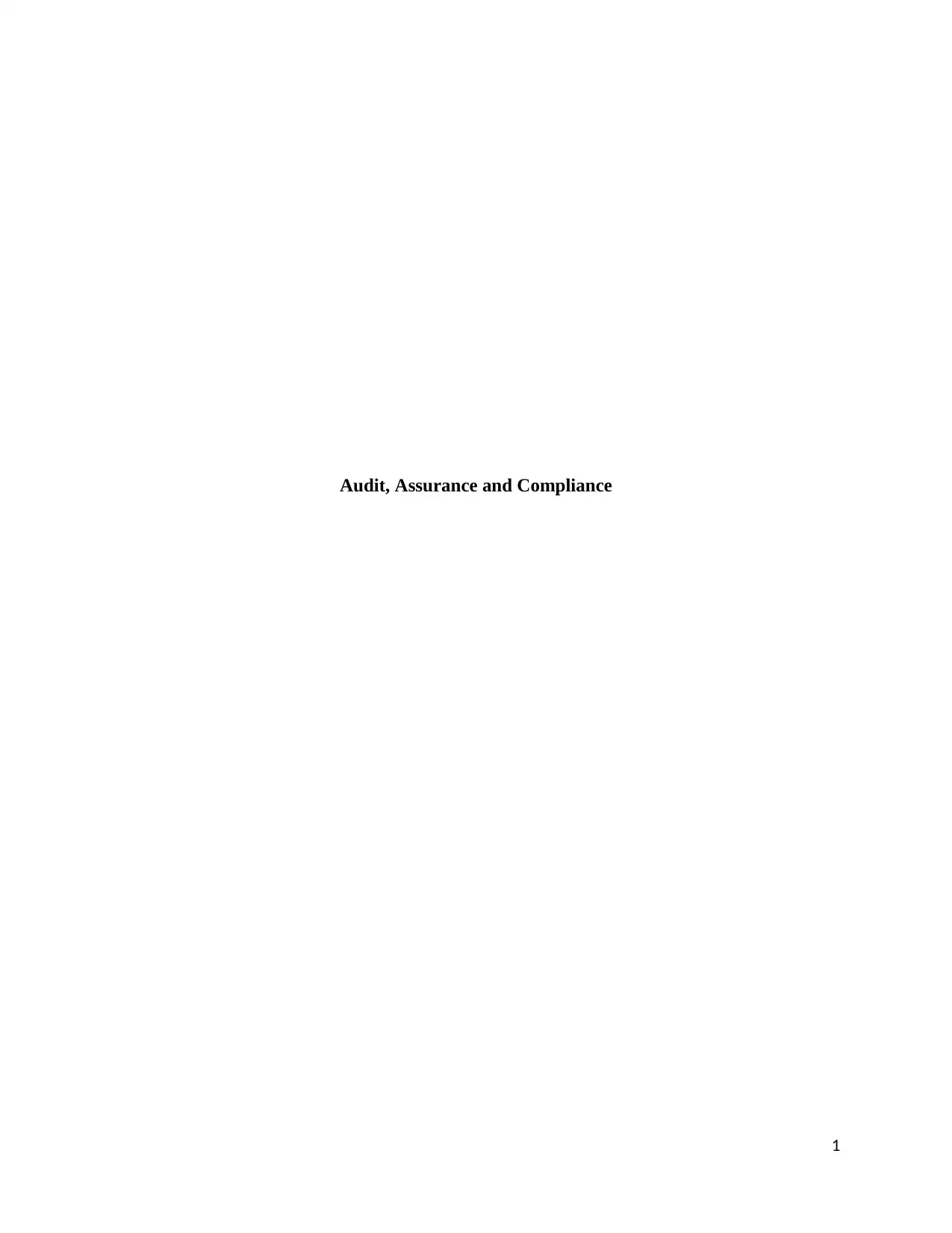
Audit, Assurance and Compliance
1
1
Paraphrase This Document
Need a fresh take? Get an instant paraphrase of this document with our AI Paraphraser
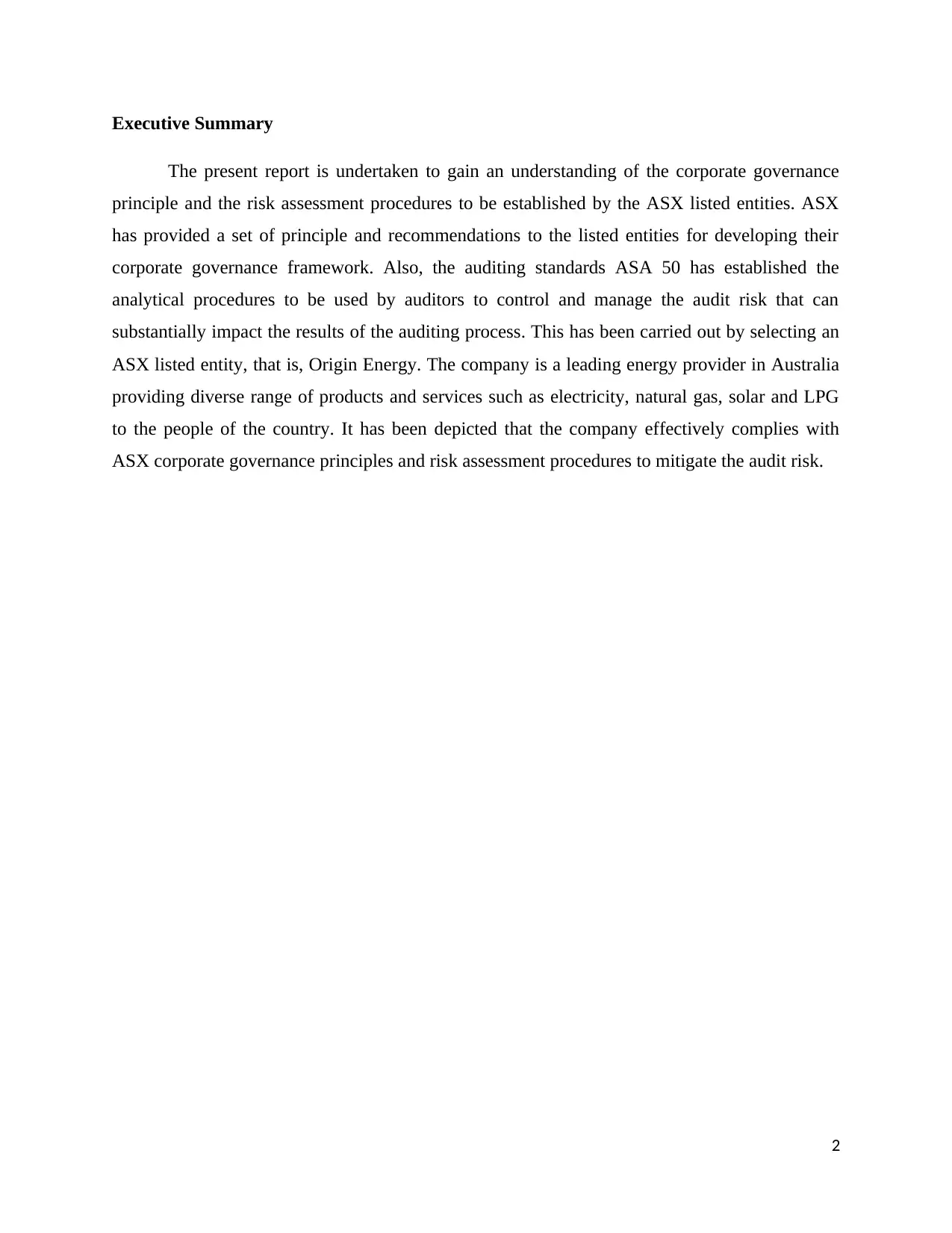
Executive Summary
The present report is undertaken to gain an understanding of the corporate governance
principle and the risk assessment procedures to be established by the ASX listed entities. ASX
has provided a set of principle and recommendations to the listed entities for developing their
corporate governance framework. Also, the auditing standards ASA 50 has established the
analytical procedures to be used by auditors to control and manage the audit risk that can
substantially impact the results of the auditing process. This has been carried out by selecting an
ASX listed entity, that is, Origin Energy. The company is a leading energy provider in Australia
providing diverse range of products and services such as electricity, natural gas, solar and LPG
to the people of the country. It has been depicted that the company effectively complies with
ASX corporate governance principles and risk assessment procedures to mitigate the audit risk.
2
The present report is undertaken to gain an understanding of the corporate governance
principle and the risk assessment procedures to be established by the ASX listed entities. ASX
has provided a set of principle and recommendations to the listed entities for developing their
corporate governance framework. Also, the auditing standards ASA 50 has established the
analytical procedures to be used by auditors to control and manage the audit risk that can
substantially impact the results of the auditing process. This has been carried out by selecting an
ASX listed entity, that is, Origin Energy. The company is a leading energy provider in Australia
providing diverse range of products and services such as electricity, natural gas, solar and LPG
to the people of the country. It has been depicted that the company effectively complies with
ASX corporate governance principles and risk assessment procedures to mitigate the audit risk.
2
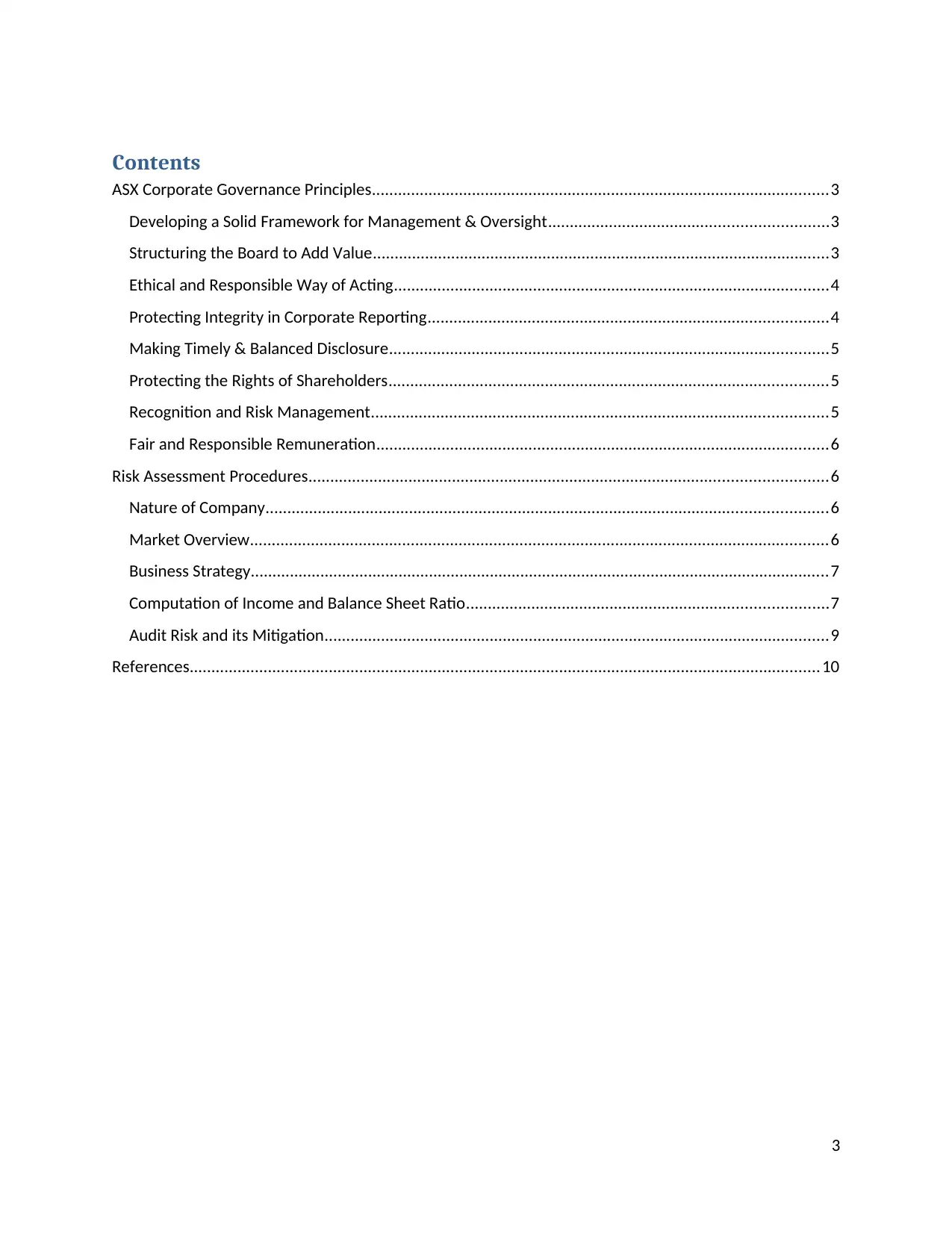
Contents
ASX Corporate Governance Principles.........................................................................................................3
Developing a Solid Framework for Management & Oversight................................................................3
Structuring the Board to Add Value.........................................................................................................3
Ethical and Responsible Way of Acting....................................................................................................4
Protecting Integrity in Corporate Reporting............................................................................................4
Making Timely & Balanced Disclosure.....................................................................................................5
Protecting the Rights of Shareholders.....................................................................................................5
Recognition and Risk Management.........................................................................................................5
Fair and Responsible Remuneration........................................................................................................6
Risk Assessment Procedures.......................................................................................................................6
Nature of Company.................................................................................................................................6
Market Overview.....................................................................................................................................6
Business Strategy.....................................................................................................................................7
Computation of Income and Balance Sheet Ratio...................................................................................7
Audit Risk and its Mitigation....................................................................................................................9
References.................................................................................................................................................10
3
ASX Corporate Governance Principles.........................................................................................................3
Developing a Solid Framework for Management & Oversight................................................................3
Structuring the Board to Add Value.........................................................................................................3
Ethical and Responsible Way of Acting....................................................................................................4
Protecting Integrity in Corporate Reporting............................................................................................4
Making Timely & Balanced Disclosure.....................................................................................................5
Protecting the Rights of Shareholders.....................................................................................................5
Recognition and Risk Management.........................................................................................................5
Fair and Responsible Remuneration........................................................................................................6
Risk Assessment Procedures.......................................................................................................................6
Nature of Company.................................................................................................................................6
Market Overview.....................................................................................................................................6
Business Strategy.....................................................................................................................................7
Computation of Income and Balance Sheet Ratio...................................................................................7
Audit Risk and its Mitigation....................................................................................................................9
References.................................................................................................................................................10
3
⊘ This is a preview!⊘
Do you want full access?
Subscribe today to unlock all pages.

Trusted by 1+ million students worldwide
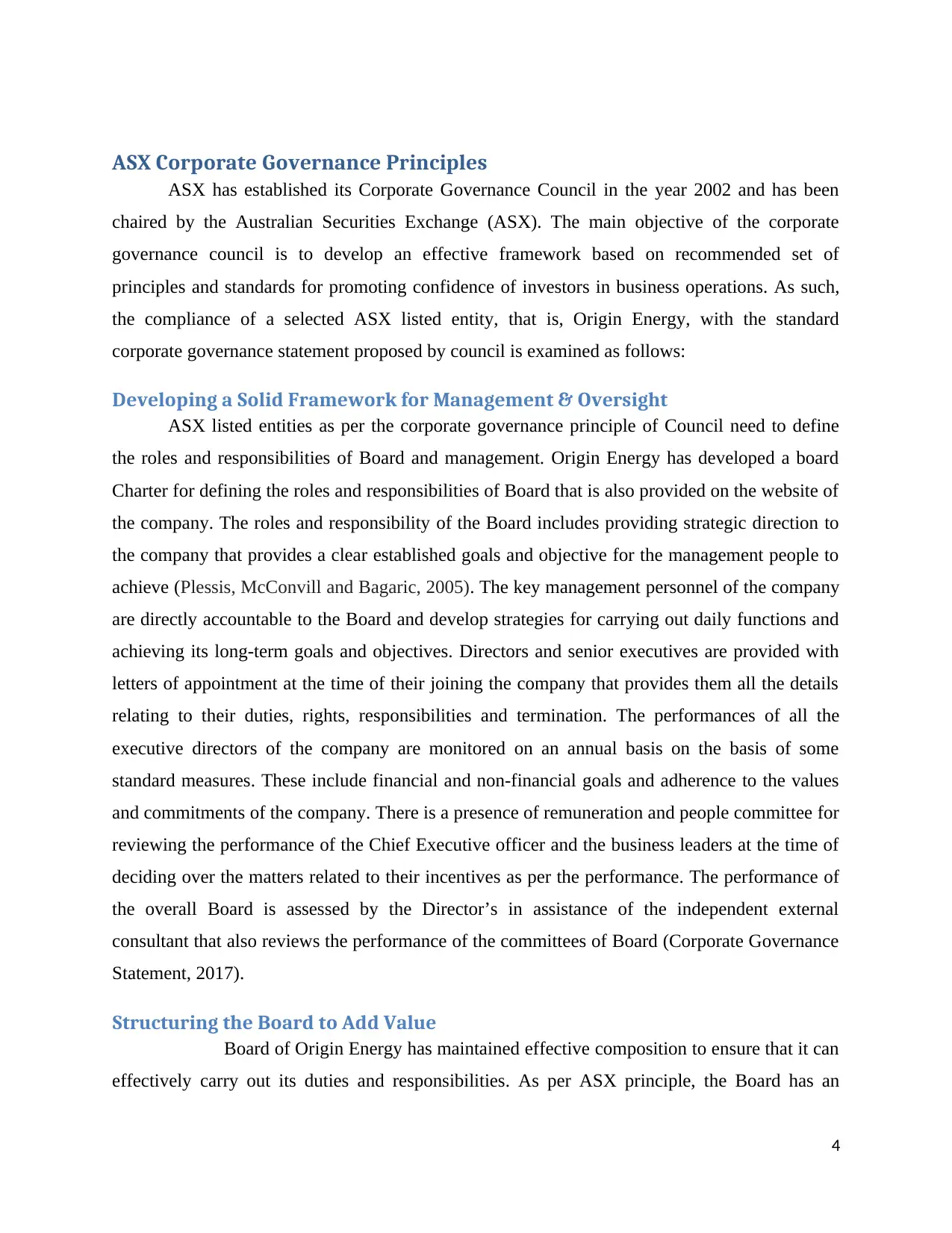
ASX Corporate Governance Principles
ASX has established its Corporate Governance Council in the year 2002 and has been
chaired by the Australian Securities Exchange (ASX). The main objective of the corporate
governance council is to develop an effective framework based on recommended set of
principles and standards for promoting confidence of investors in business operations. As such,
the compliance of a selected ASX listed entity, that is, Origin Energy, with the standard
corporate governance statement proposed by council is examined as follows:
Developing a Solid Framework for Management & Oversight
ASX listed entities as per the corporate governance principle of Council need to define
the roles and responsibilities of Board and management. Origin Energy has developed a board
Charter for defining the roles and responsibilities of Board that is also provided on the website of
the company. The roles and responsibility of the Board includes providing strategic direction to
the company that provides a clear established goals and objective for the management people to
achieve (Plessis, McConvill and Bagaric, 2005). The key management personnel of the company
are directly accountable to the Board and develop strategies for carrying out daily functions and
achieving its long-term goals and objectives. Directors and senior executives are provided with
letters of appointment at the time of their joining the company that provides them all the details
relating to their duties, rights, responsibilities and termination. The performances of all the
executive directors of the company are monitored on an annual basis on the basis of some
standard measures. These include financial and non-financial goals and adherence to the values
and commitments of the company. There is a presence of remuneration and people committee for
reviewing the performance of the Chief Executive officer and the business leaders at the time of
deciding over the matters related to their incentives as per the performance. The performance of
the overall Board is assessed by the Director’s in assistance of the independent external
consultant that also reviews the performance of the committees of Board (Corporate Governance
Statement, 2017).
Structuring the Board to Add Value
Board of Origin Energy has maintained effective composition to ensure that it can
effectively carry out its duties and responsibilities. As per ASX principle, the Board has an
4
ASX has established its Corporate Governance Council in the year 2002 and has been
chaired by the Australian Securities Exchange (ASX). The main objective of the corporate
governance council is to develop an effective framework based on recommended set of
principles and standards for promoting confidence of investors in business operations. As such,
the compliance of a selected ASX listed entity, that is, Origin Energy, with the standard
corporate governance statement proposed by council is examined as follows:
Developing a Solid Framework for Management & Oversight
ASX listed entities as per the corporate governance principle of Council need to define
the roles and responsibilities of Board and management. Origin Energy has developed a board
Charter for defining the roles and responsibilities of Board that is also provided on the website of
the company. The roles and responsibility of the Board includes providing strategic direction to
the company that provides a clear established goals and objective for the management people to
achieve (Plessis, McConvill and Bagaric, 2005). The key management personnel of the company
are directly accountable to the Board and develop strategies for carrying out daily functions and
achieving its long-term goals and objectives. Directors and senior executives are provided with
letters of appointment at the time of their joining the company that provides them all the details
relating to their duties, rights, responsibilities and termination. The performances of all the
executive directors of the company are monitored on an annual basis on the basis of some
standard measures. These include financial and non-financial goals and adherence to the values
and commitments of the company. There is a presence of remuneration and people committee for
reviewing the performance of the Chief Executive officer and the business leaders at the time of
deciding over the matters related to their incentives as per the performance. The performance of
the overall Board is assessed by the Director’s in assistance of the independent external
consultant that also reviews the performance of the committees of Board (Corporate Governance
Statement, 2017).
Structuring the Board to Add Value
Board of Origin Energy has maintained effective composition to ensure that it can
effectively carry out its duties and responsibilities. As per ASX principle, the Board has an
4
Paraphrase This Document
Need a fresh take? Get an instant paraphrase of this document with our AI Paraphraser
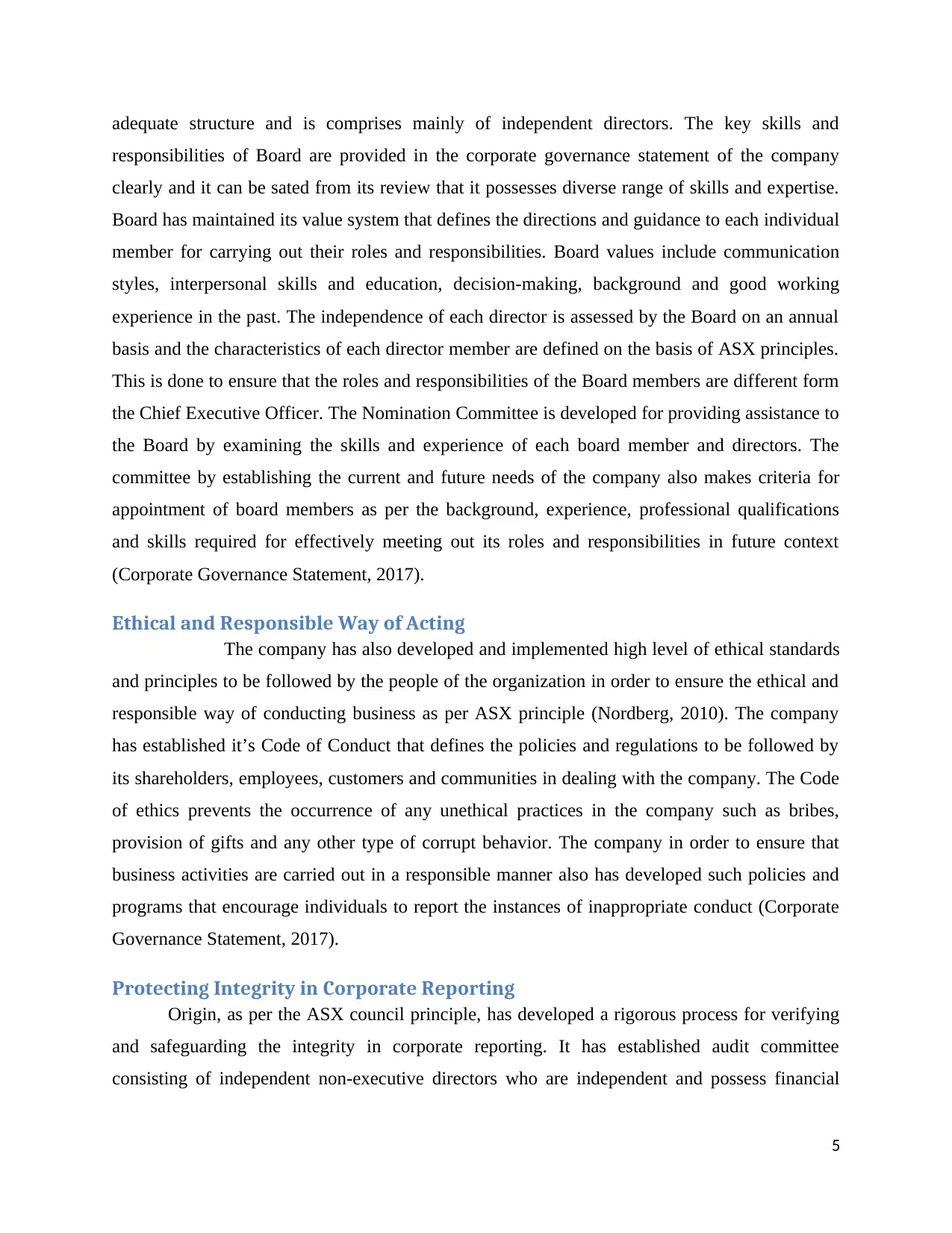
adequate structure and is comprises mainly of independent directors. The key skills and
responsibilities of Board are provided in the corporate governance statement of the company
clearly and it can be sated from its review that it possesses diverse range of skills and expertise.
Board has maintained its value system that defines the directions and guidance to each individual
member for carrying out their roles and responsibilities. Board values include communication
styles, interpersonal skills and education, decision-making, background and good working
experience in the past. The independence of each director is assessed by the Board on an annual
basis and the characteristics of each director member are defined on the basis of ASX principles.
This is done to ensure that the roles and responsibilities of the Board members are different form
the Chief Executive Officer. The Nomination Committee is developed for providing assistance to
the Board by examining the skills and experience of each board member and directors. The
committee by establishing the current and future needs of the company also makes criteria for
appointment of board members as per the background, experience, professional qualifications
and skills required for effectively meeting out its roles and responsibilities in future context
(Corporate Governance Statement, 2017).
Ethical and Responsible Way of Acting
The company has also developed and implemented high level of ethical standards
and principles to be followed by the people of the organization in order to ensure the ethical and
responsible way of conducting business as per ASX principle (Nordberg, 2010). The company
has established it’s Code of Conduct that defines the policies and regulations to be followed by
its shareholders, employees, customers and communities in dealing with the company. The Code
of ethics prevents the occurrence of any unethical practices in the company such as bribes,
provision of gifts and any other type of corrupt behavior. The company in order to ensure that
business activities are carried out in a responsible manner also has developed such policies and
programs that encourage individuals to report the instances of inappropriate conduct (Corporate
Governance Statement, 2017).
Protecting Integrity in Corporate Reporting
Origin, as per the ASX council principle, has developed a rigorous process for verifying
and safeguarding the integrity in corporate reporting. It has established audit committee
consisting of independent non-executive directors who are independent and possess financial
5
responsibilities of Board are provided in the corporate governance statement of the company
clearly and it can be sated from its review that it possesses diverse range of skills and expertise.
Board has maintained its value system that defines the directions and guidance to each individual
member for carrying out their roles and responsibilities. Board values include communication
styles, interpersonal skills and education, decision-making, background and good working
experience in the past. The independence of each director is assessed by the Board on an annual
basis and the characteristics of each director member are defined on the basis of ASX principles.
This is done to ensure that the roles and responsibilities of the Board members are different form
the Chief Executive Officer. The Nomination Committee is developed for providing assistance to
the Board by examining the skills and experience of each board member and directors. The
committee by establishing the current and future needs of the company also makes criteria for
appointment of board members as per the background, experience, professional qualifications
and skills required for effectively meeting out its roles and responsibilities in future context
(Corporate Governance Statement, 2017).
Ethical and Responsible Way of Acting
The company has also developed and implemented high level of ethical standards
and principles to be followed by the people of the organization in order to ensure the ethical and
responsible way of conducting business as per ASX principle (Nordberg, 2010). The company
has established it’s Code of Conduct that defines the policies and regulations to be followed by
its shareholders, employees, customers and communities in dealing with the company. The Code
of ethics prevents the occurrence of any unethical practices in the company such as bribes,
provision of gifts and any other type of corrupt behavior. The company in order to ensure that
business activities are carried out in a responsible manner also has developed such policies and
programs that encourage individuals to report the instances of inappropriate conduct (Corporate
Governance Statement, 2017).
Protecting Integrity in Corporate Reporting
Origin, as per the ASX council principle, has developed a rigorous process for verifying
and safeguarding the integrity in corporate reporting. It has established audit committee
consisting of independent non-executive directors who are independent and possess financial
5
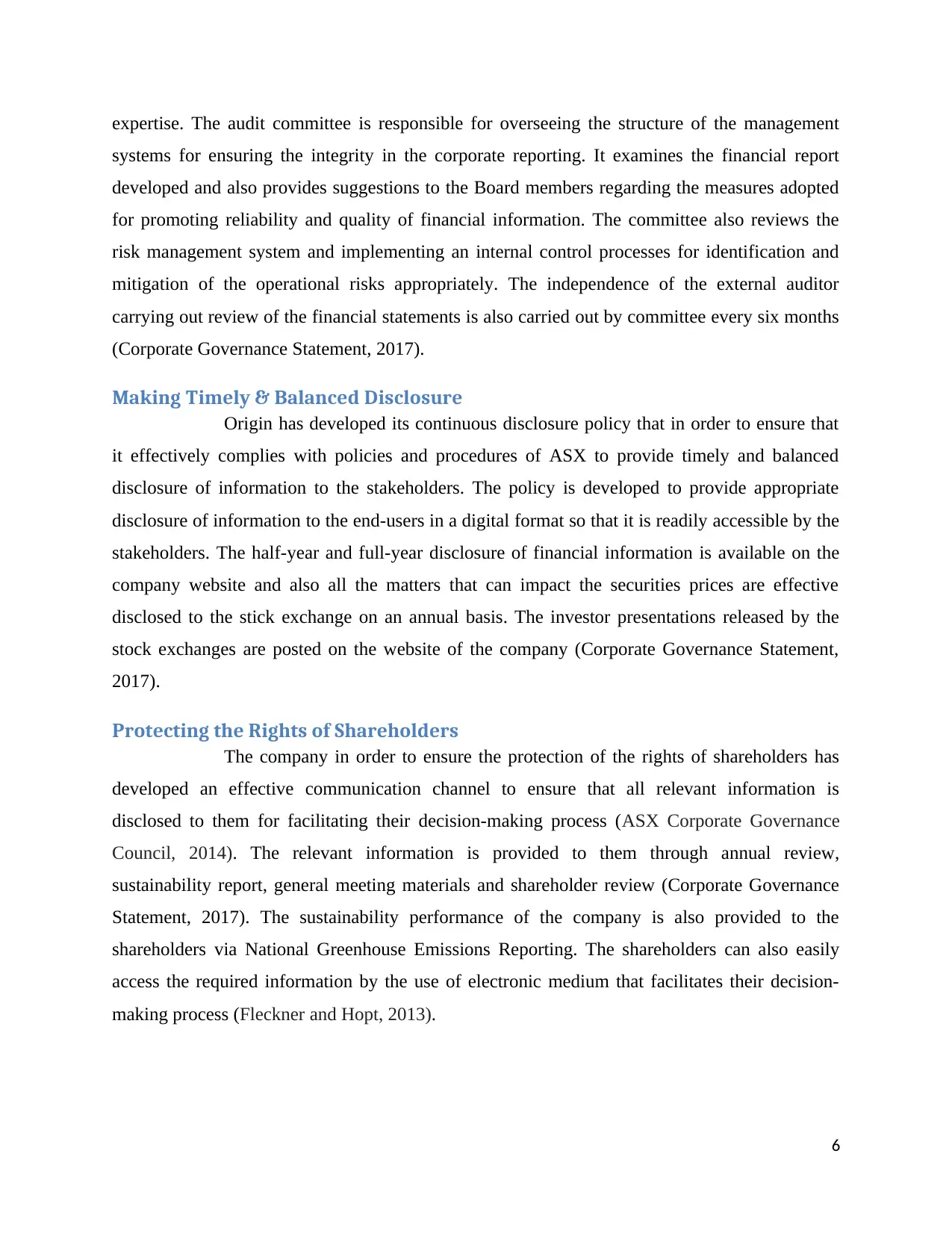
expertise. The audit committee is responsible for overseeing the structure of the management
systems for ensuring the integrity in the corporate reporting. It examines the financial report
developed and also provides suggestions to the Board members regarding the measures adopted
for promoting reliability and quality of financial information. The committee also reviews the
risk management system and implementing an internal control processes for identification and
mitigation of the operational risks appropriately. The independence of the external auditor
carrying out review of the financial statements is also carried out by committee every six months
(Corporate Governance Statement, 2017).
Making Timely & Balanced Disclosure
Origin has developed its continuous disclosure policy that in order to ensure that
it effectively complies with policies and procedures of ASX to provide timely and balanced
disclosure of information to the stakeholders. The policy is developed to provide appropriate
disclosure of information to the end-users in a digital format so that it is readily accessible by the
stakeholders. The half-year and full-year disclosure of financial information is available on the
company website and also all the matters that can impact the securities prices are effective
disclosed to the stick exchange on an annual basis. The investor presentations released by the
stock exchanges are posted on the website of the company (Corporate Governance Statement,
2017).
Protecting the Rights of Shareholders
The company in order to ensure the protection of the rights of shareholders has
developed an effective communication channel to ensure that all relevant information is
disclosed to them for facilitating their decision-making process (ASX Corporate Governance
Council, 2014). The relevant information is provided to them through annual review,
sustainability report, general meeting materials and shareholder review (Corporate Governance
Statement, 2017). The sustainability performance of the company is also provided to the
shareholders via National Greenhouse Emissions Reporting. The shareholders can also easily
access the required information by the use of electronic medium that facilitates their decision-
making process (Fleckner and Hopt, 2013).
6
systems for ensuring the integrity in the corporate reporting. It examines the financial report
developed and also provides suggestions to the Board members regarding the measures adopted
for promoting reliability and quality of financial information. The committee also reviews the
risk management system and implementing an internal control processes for identification and
mitigation of the operational risks appropriately. The independence of the external auditor
carrying out review of the financial statements is also carried out by committee every six months
(Corporate Governance Statement, 2017).
Making Timely & Balanced Disclosure
Origin has developed its continuous disclosure policy that in order to ensure that
it effectively complies with policies and procedures of ASX to provide timely and balanced
disclosure of information to the stakeholders. The policy is developed to provide appropriate
disclosure of information to the end-users in a digital format so that it is readily accessible by the
stakeholders. The half-year and full-year disclosure of financial information is available on the
company website and also all the matters that can impact the securities prices are effective
disclosed to the stick exchange on an annual basis. The investor presentations released by the
stock exchanges are posted on the website of the company (Corporate Governance Statement,
2017).
Protecting the Rights of Shareholders
The company in order to ensure the protection of the rights of shareholders has
developed an effective communication channel to ensure that all relevant information is
disclosed to them for facilitating their decision-making process (ASX Corporate Governance
Council, 2014). The relevant information is provided to them through annual review,
sustainability report, general meeting materials and shareholder review (Corporate Governance
Statement, 2017). The sustainability performance of the company is also provided to the
shareholders via National Greenhouse Emissions Reporting. The shareholders can also easily
access the required information by the use of electronic medium that facilitates their decision-
making process (Fleckner and Hopt, 2013).
6
⊘ This is a preview!⊘
Do you want full access?
Subscribe today to unlock all pages.

Trusted by 1+ million students worldwide
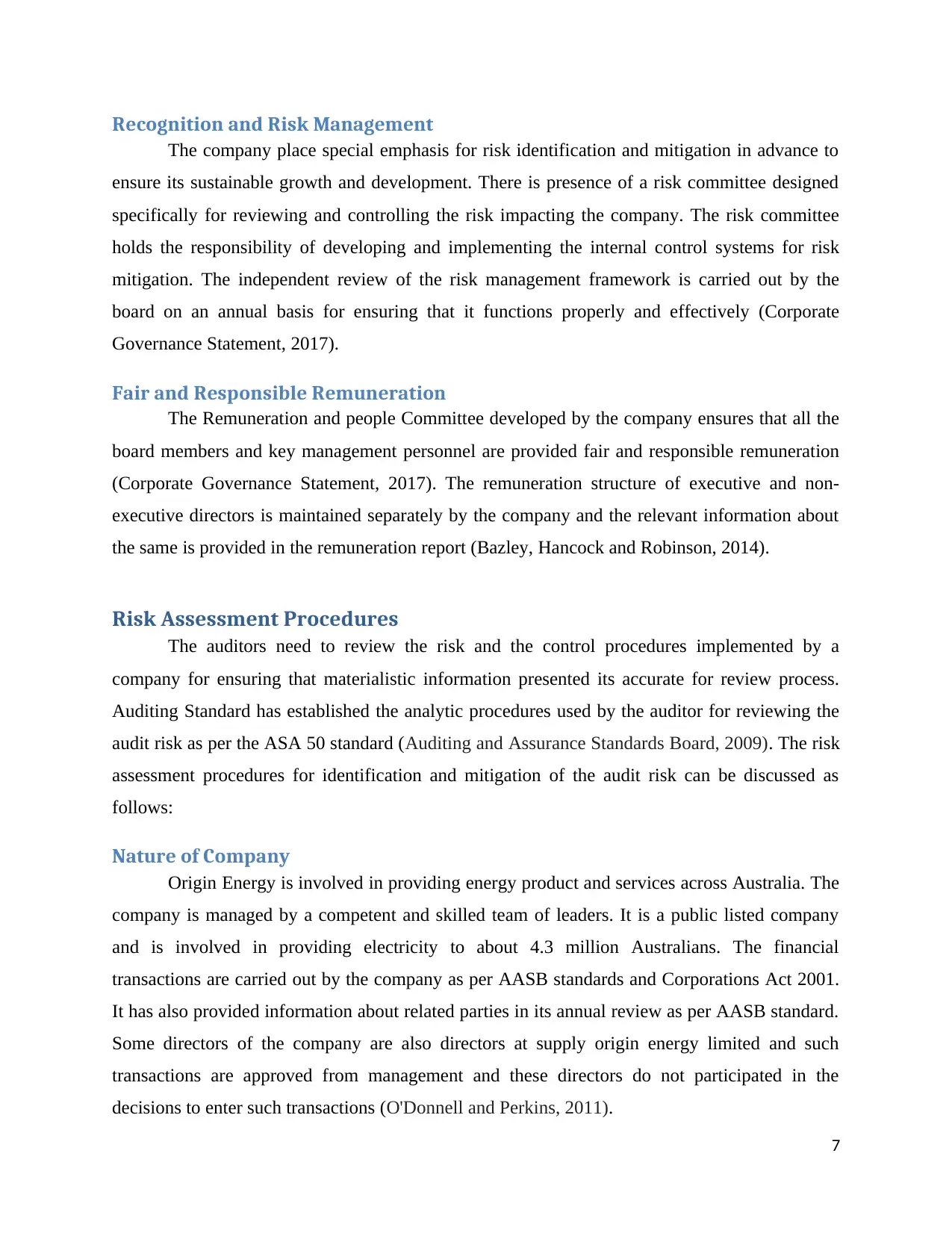
Recognition and Risk Management
The company place special emphasis for risk identification and mitigation in advance to
ensure its sustainable growth and development. There is presence of a risk committee designed
specifically for reviewing and controlling the risk impacting the company. The risk committee
holds the responsibility of developing and implementing the internal control systems for risk
mitigation. The independent review of the risk management framework is carried out by the
board on an annual basis for ensuring that it functions properly and effectively (Corporate
Governance Statement, 2017).
Fair and Responsible Remuneration
The Remuneration and people Committee developed by the company ensures that all the
board members and key management personnel are provided fair and responsible remuneration
(Corporate Governance Statement, 2017). The remuneration structure of executive and non-
executive directors is maintained separately by the company and the relevant information about
the same is provided in the remuneration report (Bazley, Hancock and Robinson, 2014).
Risk Assessment Procedures
The auditors need to review the risk and the control procedures implemented by a
company for ensuring that materialistic information presented its accurate for review process.
Auditing Standard has established the analytic procedures used by the auditor for reviewing the
audit risk as per the ASA 50 standard (Auditing and Assurance Standards Board, 2009). The risk
assessment procedures for identification and mitigation of the audit risk can be discussed as
follows:
Nature of Company
Origin Energy is involved in providing energy product and services across Australia. The
company is managed by a competent and skilled team of leaders. It is a public listed company
and is involved in providing electricity to about 4.3 million Australians. The financial
transactions are carried out by the company as per AASB standards and Corporations Act 2001.
It has also provided information about related parties in its annual review as per AASB standard.
Some directors of the company are also directors at supply origin energy limited and such
transactions are approved from management and these directors do not participated in the
decisions to enter such transactions (O'Donnell and Perkins, 2011).
7
The company place special emphasis for risk identification and mitigation in advance to
ensure its sustainable growth and development. There is presence of a risk committee designed
specifically for reviewing and controlling the risk impacting the company. The risk committee
holds the responsibility of developing and implementing the internal control systems for risk
mitigation. The independent review of the risk management framework is carried out by the
board on an annual basis for ensuring that it functions properly and effectively (Corporate
Governance Statement, 2017).
Fair and Responsible Remuneration
The Remuneration and people Committee developed by the company ensures that all the
board members and key management personnel are provided fair and responsible remuneration
(Corporate Governance Statement, 2017). The remuneration structure of executive and non-
executive directors is maintained separately by the company and the relevant information about
the same is provided in the remuneration report (Bazley, Hancock and Robinson, 2014).
Risk Assessment Procedures
The auditors need to review the risk and the control procedures implemented by a
company for ensuring that materialistic information presented its accurate for review process.
Auditing Standard has established the analytic procedures used by the auditor for reviewing the
audit risk as per the ASA 50 standard (Auditing and Assurance Standards Board, 2009). The risk
assessment procedures for identification and mitigation of the audit risk can be discussed as
follows:
Nature of Company
Origin Energy is involved in providing energy product and services across Australia. The
company is managed by a competent and skilled team of leaders. It is a public listed company
and is involved in providing electricity to about 4.3 million Australians. The financial
transactions are carried out by the company as per AASB standards and Corporations Act 2001.
It has also provided information about related parties in its annual review as per AASB standard.
Some directors of the company are also directors at supply origin energy limited and such
transactions are approved from management and these directors do not participated in the
decisions to enter such transactions (O'Donnell and Perkins, 2011).
7
Paraphrase This Document
Need a fresh take? Get an instant paraphrase of this document with our AI Paraphraser
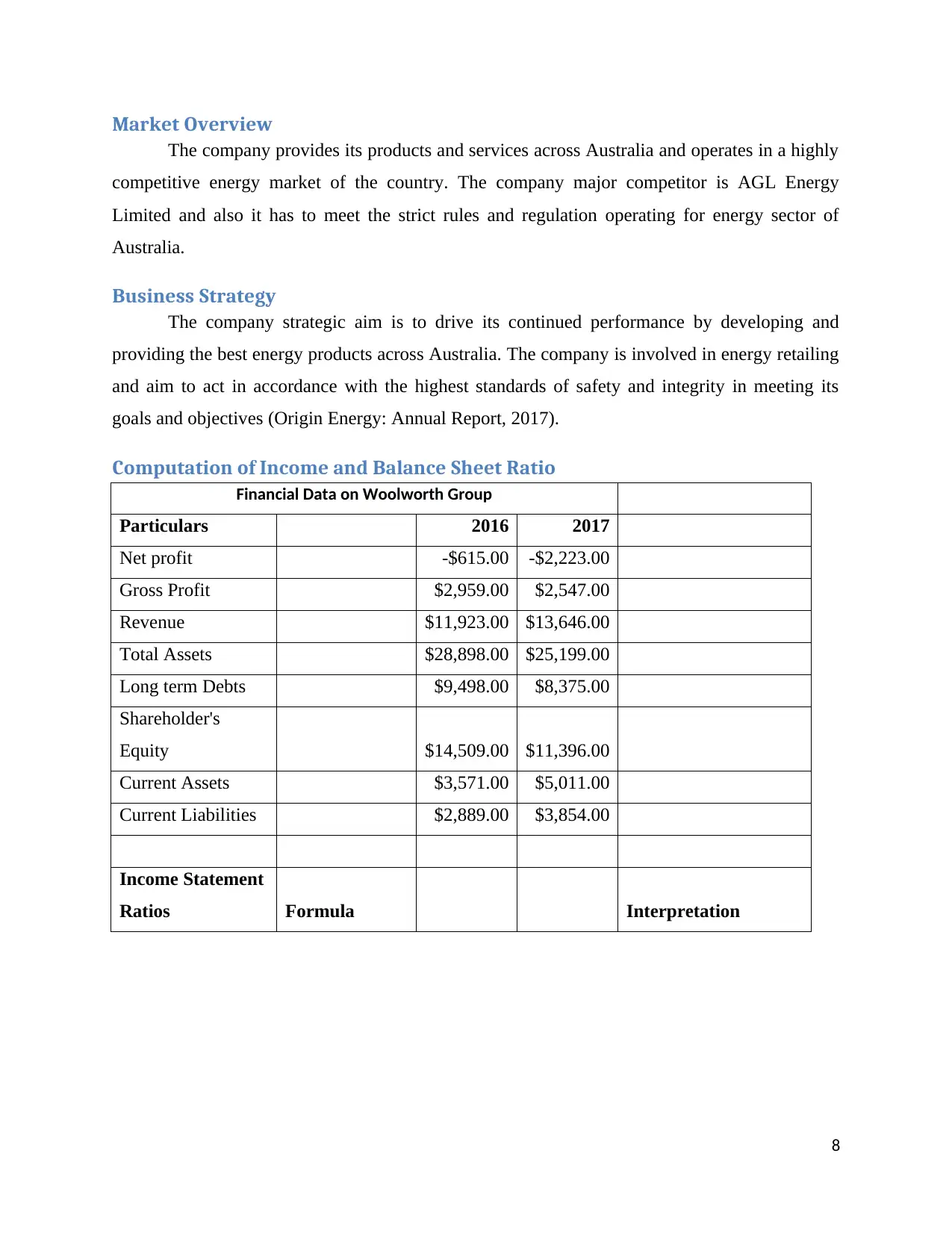
Market Overview
The company provides its products and services across Australia and operates in a highly
competitive energy market of the country. The company major competitor is AGL Energy
Limited and also it has to meet the strict rules and regulation operating for energy sector of
Australia.
Business Strategy
The company strategic aim is to drive its continued performance by developing and
providing the best energy products across Australia. The company is involved in energy retailing
and aim to act in accordance with the highest standards of safety and integrity in meeting its
goals and objectives (Origin Energy: Annual Report, 2017).
Computation of Income and Balance Sheet Ratio
Financial Data on Woolworth Group
Particulars 2016 2017
Net profit -$615.00 -$2,223.00
Gross Profit $2,959.00 $2,547.00
Revenue $11,923.00 $13,646.00
Total Assets $28,898.00 $25,199.00
Long term Debts $9,498.00 $8,375.00
Shareholder's
Equity $14,509.00 $11,396.00
Current Assets $3,571.00 $5,011.00
Current Liabilities $2,889.00 $3,854.00
Income Statement
Ratios Formula Interpretation
8
The company provides its products and services across Australia and operates in a highly
competitive energy market of the country. The company major competitor is AGL Energy
Limited and also it has to meet the strict rules and regulation operating for energy sector of
Australia.
Business Strategy
The company strategic aim is to drive its continued performance by developing and
providing the best energy products across Australia. The company is involved in energy retailing
and aim to act in accordance with the highest standards of safety and integrity in meeting its
goals and objectives (Origin Energy: Annual Report, 2017).
Computation of Income and Balance Sheet Ratio
Financial Data on Woolworth Group
Particulars 2016 2017
Net profit -$615.00 -$2,223.00
Gross Profit $2,959.00 $2,547.00
Revenue $11,923.00 $13,646.00
Total Assets $28,898.00 $25,199.00
Long term Debts $9,498.00 $8,375.00
Shareholder's
Equity $14,509.00 $11,396.00
Current Assets $3,571.00 $5,011.00
Current Liabilities $2,889.00 $3,854.00
Income Statement
Ratios Formula Interpretation
8
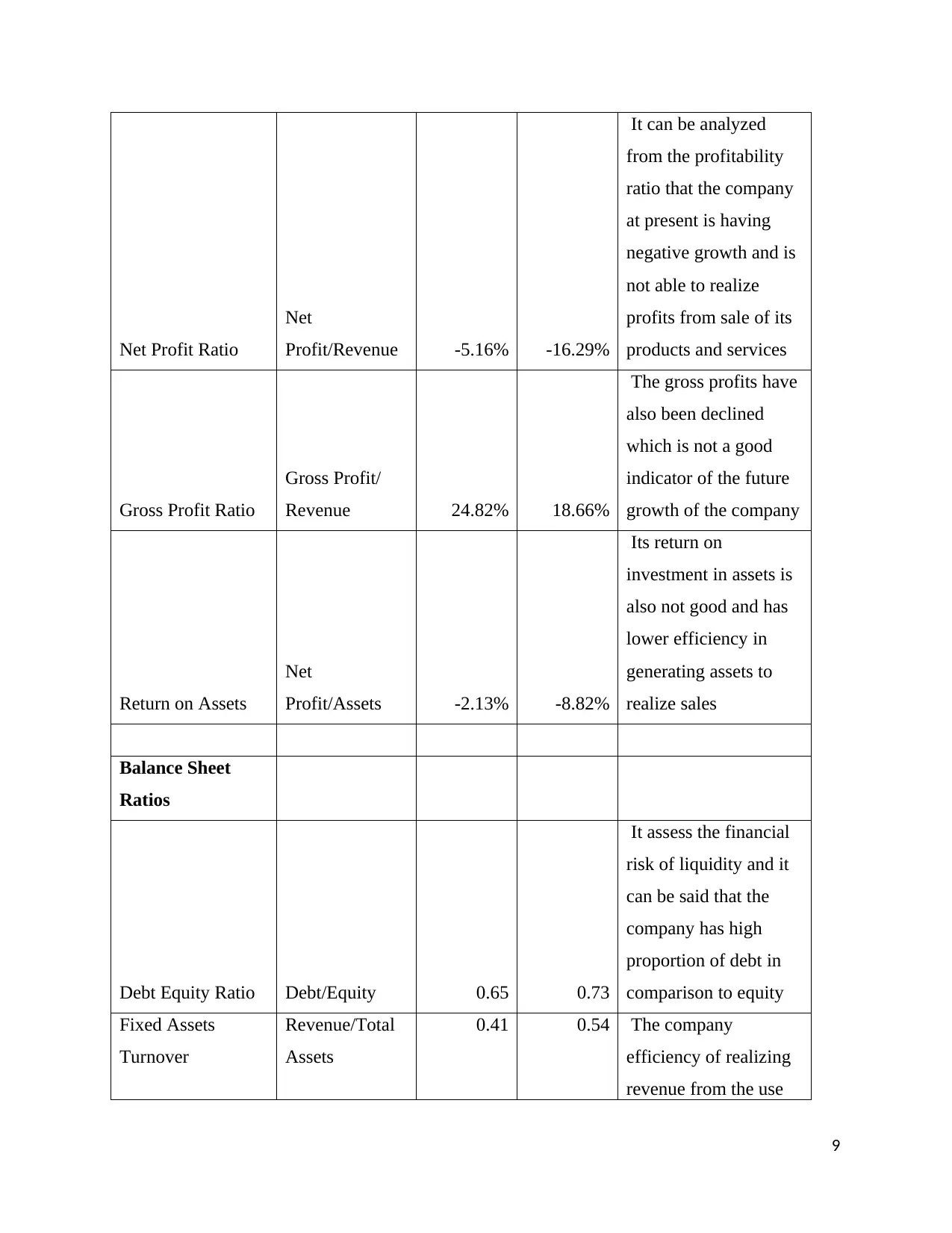
Net Profit Ratio
Net
Profit/Revenue -5.16% -16.29%
It can be analyzed
from the profitability
ratio that the company
at present is having
negative growth and is
not able to realize
profits from sale of its
products and services
Gross Profit Ratio
Gross Profit/
Revenue 24.82% 18.66%
The gross profits have
also been declined
which is not a good
indicator of the future
growth of the company
Return on Assets
Net
Profit/Assets -2.13% -8.82%
Its return on
investment in assets is
also not good and has
lower efficiency in
generating assets to
realize sales
Balance Sheet
Ratios
Debt Equity Ratio Debt/Equity 0.65 0.73
It assess the financial
risk of liquidity and it
can be said that the
company has high
proportion of debt in
comparison to equity
Fixed Assets
Turnover
Revenue/Total
Assets
0.41 0.54 The company
efficiency of realizing
revenue from the use
9
Net
Profit/Revenue -5.16% -16.29%
It can be analyzed
from the profitability
ratio that the company
at present is having
negative growth and is
not able to realize
profits from sale of its
products and services
Gross Profit Ratio
Gross Profit/
Revenue 24.82% 18.66%
The gross profits have
also been declined
which is not a good
indicator of the future
growth of the company
Return on Assets
Net
Profit/Assets -2.13% -8.82%
Its return on
investment in assets is
also not good and has
lower efficiency in
generating assets to
realize sales
Balance Sheet
Ratios
Debt Equity Ratio Debt/Equity 0.65 0.73
It assess the financial
risk of liquidity and it
can be said that the
company has high
proportion of debt in
comparison to equity
Fixed Assets
Turnover
Revenue/Total
Assets
0.41 0.54 The company
efficiency of realizing
revenue from the use
9
⊘ This is a preview!⊘
Do you want full access?
Subscribe today to unlock all pages.

Trusted by 1+ million students worldwide
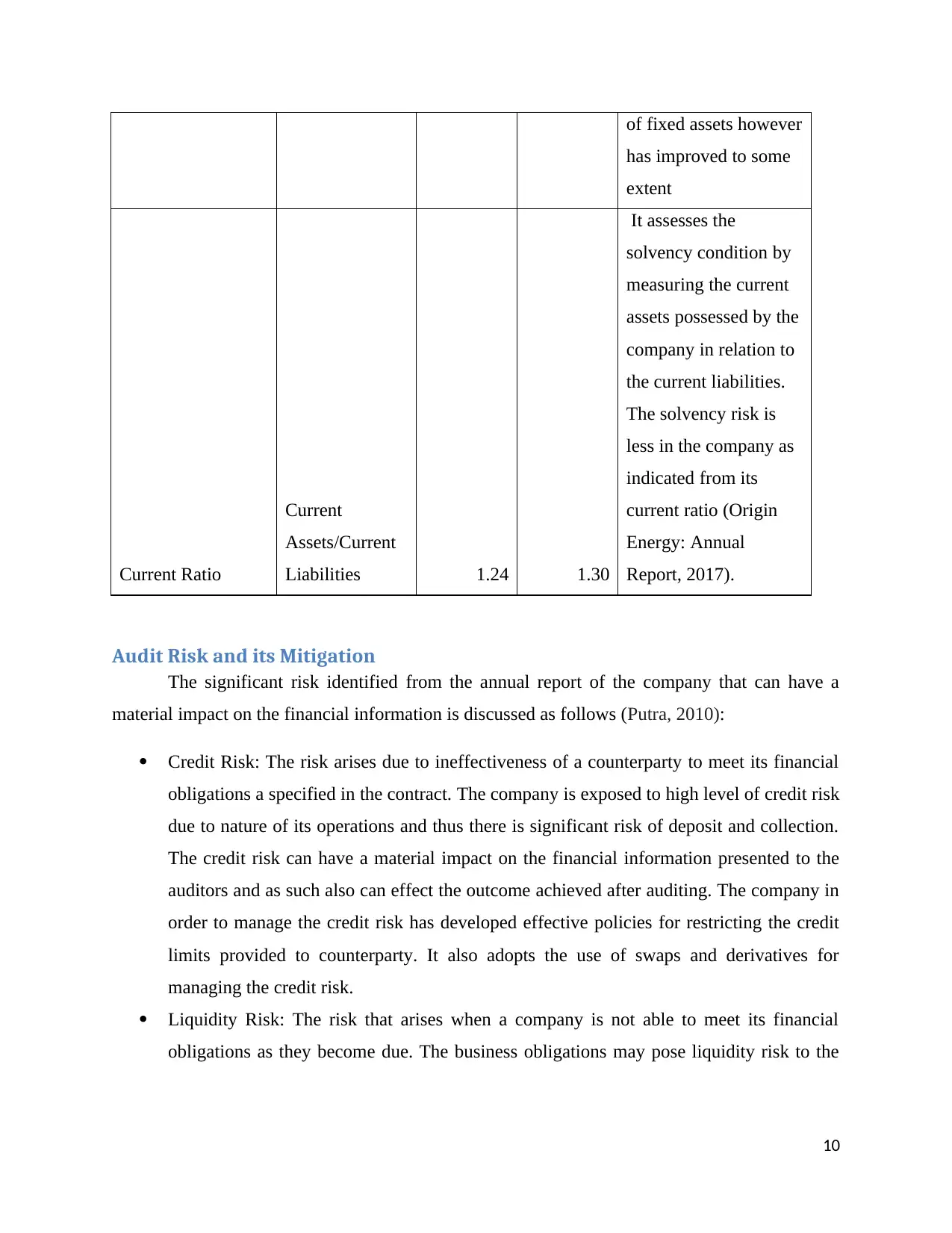
of fixed assets however
has improved to some
extent
Current Ratio
Current
Assets/Current
Liabilities 1.24 1.30
It assesses the
solvency condition by
measuring the current
assets possessed by the
company in relation to
the current liabilities.
The solvency risk is
less in the company as
indicated from its
current ratio (Origin
Energy: Annual
Report, 2017).
Audit Risk and its Mitigation
The significant risk identified from the annual report of the company that can have a
material impact on the financial information is discussed as follows (Putra, 2010):
Credit Risk: The risk arises due to ineffectiveness of a counterparty to meet its financial
obligations a specified in the contract. The company is exposed to high level of credit risk
due to nature of its operations and thus there is significant risk of deposit and collection.
The credit risk can have a material impact on the financial information presented to the
auditors and as such also can effect the outcome achieved after auditing. The company in
order to manage the credit risk has developed effective policies for restricting the credit
limits provided to counterparty. It also adopts the use of swaps and derivatives for
managing the credit risk.
Liquidity Risk: The risk that arises when a company is not able to meet its financial
obligations as they become due. The business obligations may pose liquidity risk to the
10
has improved to some
extent
Current Ratio
Current
Assets/Current
Liabilities 1.24 1.30
It assesses the
solvency condition by
measuring the current
assets possessed by the
company in relation to
the current liabilities.
The solvency risk is
less in the company as
indicated from its
current ratio (Origin
Energy: Annual
Report, 2017).
Audit Risk and its Mitigation
The significant risk identified from the annual report of the company that can have a
material impact on the financial information is discussed as follows (Putra, 2010):
Credit Risk: The risk arises due to ineffectiveness of a counterparty to meet its financial
obligations a specified in the contract. The company is exposed to high level of credit risk
due to nature of its operations and thus there is significant risk of deposit and collection.
The credit risk can have a material impact on the financial information presented to the
auditors and as such also can effect the outcome achieved after auditing. The company in
order to manage the credit risk has developed effective policies for restricting the credit
limits provided to counterparty. It also adopts the use of swaps and derivatives for
managing the credit risk.
Liquidity Risk: The risk that arises when a company is not able to meet its financial
obligations as they become due. The business obligations may pose liquidity risk to the
10
Paraphrase This Document
Need a fresh take? Get an instant paraphrase of this document with our AI Paraphraser
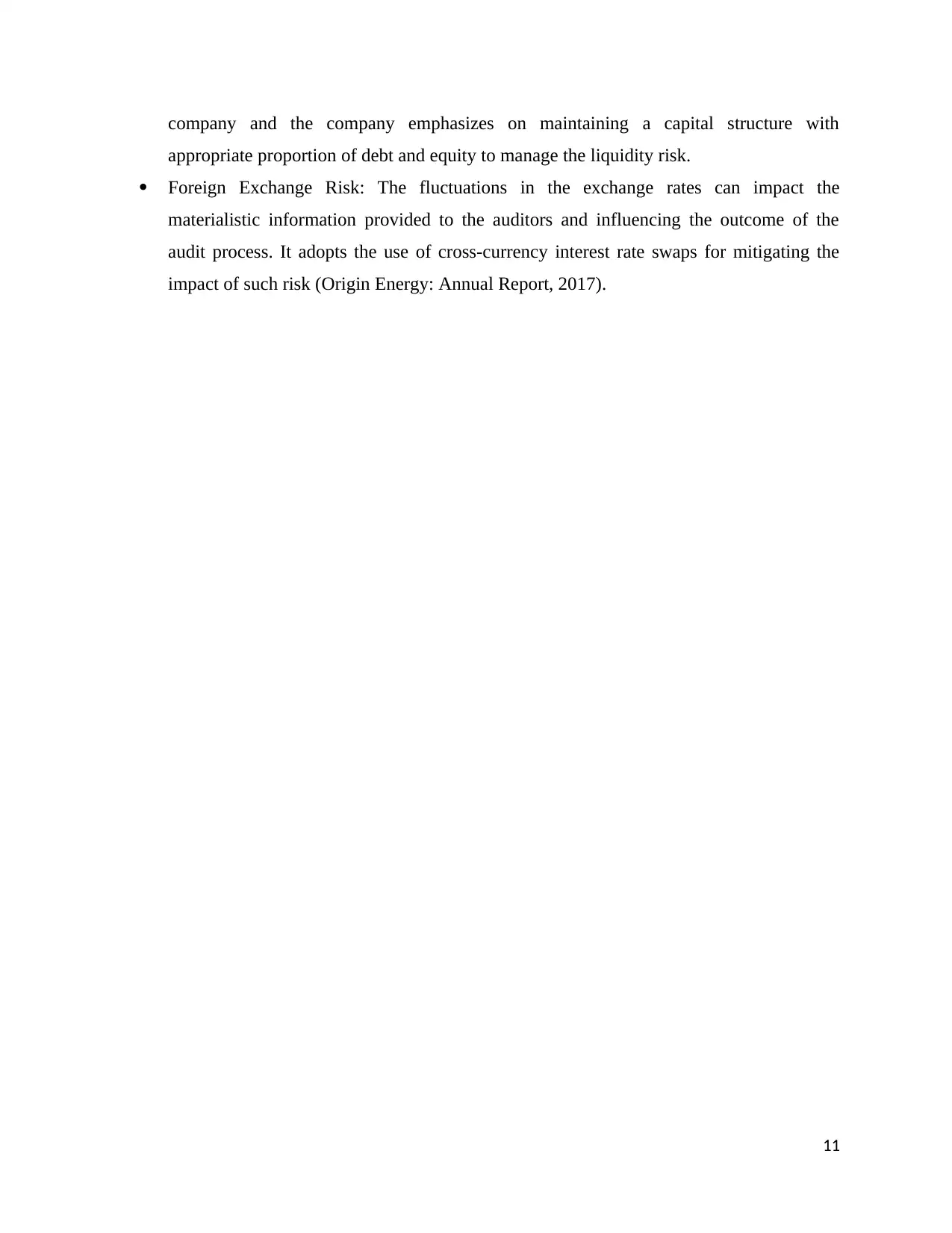
company and the company emphasizes on maintaining a capital structure with
appropriate proportion of debt and equity to manage the liquidity risk.
Foreign Exchange Risk: The fluctuations in the exchange rates can impact the
materialistic information provided to the auditors and influencing the outcome of the
audit process. It adopts the use of cross-currency interest rate swaps for mitigating the
impact of such risk (Origin Energy: Annual Report, 2017).
11
appropriate proportion of debt and equity to manage the liquidity risk.
Foreign Exchange Risk: The fluctuations in the exchange rates can impact the
materialistic information provided to the auditors and influencing the outcome of the
audit process. It adopts the use of cross-currency interest rate swaps for mitigating the
impact of such risk (Origin Energy: Annual Report, 2017).
11
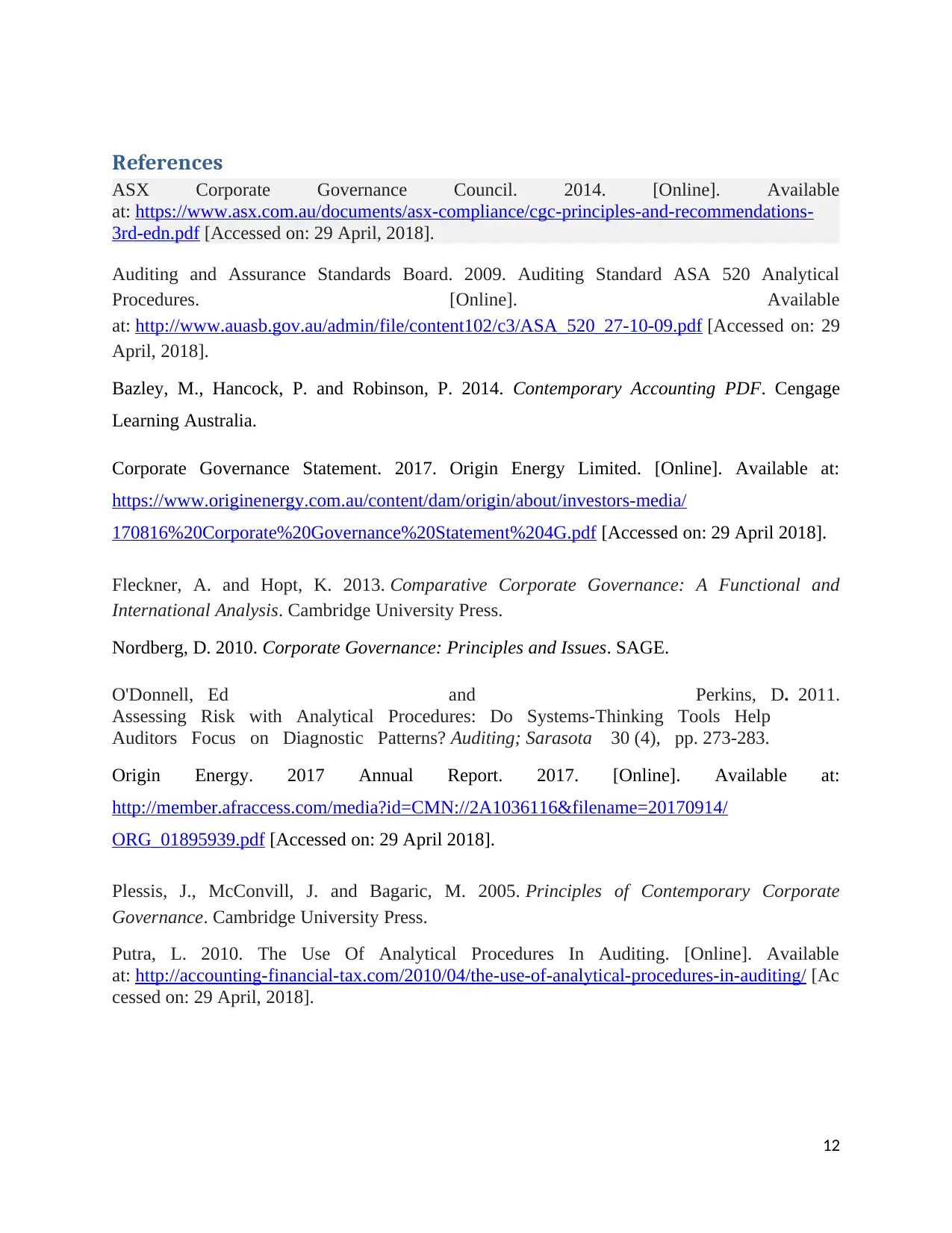
References
ASX Corporate Governance Council. 2014. [Online]. Available
at: https://www.asx.com.au/documents/asx-compliance/cgc-principles-and-recommendations-
3rd-edn.pdf [Accessed on: 29 April, 2018].
Auditing and Assurance Standards Board. 2009. Auditing Standard ASA 520 Analytical
Procedures. [Online]. Available
at: http://www.auasb.gov.au/admin/file/content102/c3/ASA_520_27-10-09.pdf [Accessed on: 29
April, 2018].
Bazley, M., Hancock, P. and Robinson, P. 2014. Contemporary Accounting PDF. Cengage
Learning Australia.
Corporate Governance Statement. 2017. Origin Energy Limited. [Online]. Available at:
https://www.originenergy.com.au/content/dam/origin/about/investors-media/
170816%20Corporate%20Governance%20Statement%204G.pdf [Accessed on: 29 April 2018].
Fleckner, A. and Hopt, K. 2013. Comparative Corporate Governance: A Functional and
International Analysis. Cambridge University Press.
Nordberg, D. 2010. Corporate Governance: Principles and Issues. SAGE.
O'Donnell, Ed and Perkins, D. 2011.
Assessing Risk with Analytical Procedures: Do Systems-Thinking Tools Help
Auditors Focus on Diagnostic Patterns? Auditing; Sarasota 30 (4), pp. 273-283.
Origin Energy. 2017 Annual Report. 2017. [Online]. Available at:
http://member.afraccess.com/media?id=CMN://2A1036116&filename=20170914/
ORG_01895939.pdf [Accessed on: 29 April 2018].
Plessis, J., McConvill, J. and Bagaric, M. 2005. Principles of Contemporary Corporate
Governance. Cambridge University Press.
Putra, L. 2010. The Use Of Analytical Procedures In Auditing. [Online]. Available
at: http://accounting-financial-tax.com/2010/04/the-use-of-analytical-procedures-in-auditing/ [Ac
cessed on: 29 April, 2018].
12
ASX Corporate Governance Council. 2014. [Online]. Available
at: https://www.asx.com.au/documents/asx-compliance/cgc-principles-and-recommendations-
3rd-edn.pdf [Accessed on: 29 April, 2018].
Auditing and Assurance Standards Board. 2009. Auditing Standard ASA 520 Analytical
Procedures. [Online]. Available
at: http://www.auasb.gov.au/admin/file/content102/c3/ASA_520_27-10-09.pdf [Accessed on: 29
April, 2018].
Bazley, M., Hancock, P. and Robinson, P. 2014. Contemporary Accounting PDF. Cengage
Learning Australia.
Corporate Governance Statement. 2017. Origin Energy Limited. [Online]. Available at:
https://www.originenergy.com.au/content/dam/origin/about/investors-media/
170816%20Corporate%20Governance%20Statement%204G.pdf [Accessed on: 29 April 2018].
Fleckner, A. and Hopt, K. 2013. Comparative Corporate Governance: A Functional and
International Analysis. Cambridge University Press.
Nordberg, D. 2010. Corporate Governance: Principles and Issues. SAGE.
O'Donnell, Ed and Perkins, D. 2011.
Assessing Risk with Analytical Procedures: Do Systems-Thinking Tools Help
Auditors Focus on Diagnostic Patterns? Auditing; Sarasota 30 (4), pp. 273-283.
Origin Energy. 2017 Annual Report. 2017. [Online]. Available at:
http://member.afraccess.com/media?id=CMN://2A1036116&filename=20170914/
ORG_01895939.pdf [Accessed on: 29 April 2018].
Plessis, J., McConvill, J. and Bagaric, M. 2005. Principles of Contemporary Corporate
Governance. Cambridge University Press.
Putra, L. 2010. The Use Of Analytical Procedures In Auditing. [Online]. Available
at: http://accounting-financial-tax.com/2010/04/the-use-of-analytical-procedures-in-auditing/ [Ac
cessed on: 29 April, 2018].
12
⊘ This is a preview!⊘
Do you want full access?
Subscribe today to unlock all pages.

Trusted by 1+ million students worldwide
1 out of 12
Related Documents
Your All-in-One AI-Powered Toolkit for Academic Success.
+13062052269
info@desklib.com
Available 24*7 on WhatsApp / Email
![[object Object]](/_next/static/media/star-bottom.7253800d.svg)
Unlock your academic potential
Copyright © 2020–2025 A2Z Services. All Rights Reserved. Developed and managed by ZUCOL.





